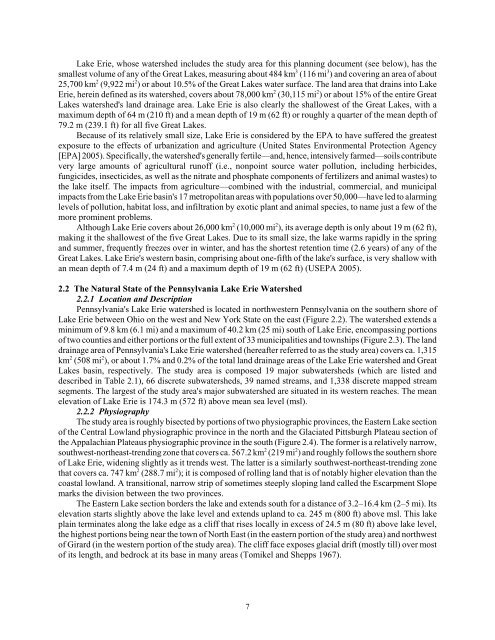Watershed Conservation Plan - Destination Erie
Watershed Conservation Plan - Destination Erie
Watershed Conservation Plan - Destination Erie
You also want an ePaper? Increase the reach of your titles
YUMPU automatically turns print PDFs into web optimized ePapers that Google loves.
Lake <strong>Erie</strong>, whose watershed includes the study area for this planning document (see below), has the<br />
smallest volume of any of the Great Lakes, measuring about 484 km 3 (116 mi 3 ) and covering an area of about<br />
25,700 km 2 (9,922 mi 2 ) or about 10.5% of the Great Lakes water surface. The land area that drains into Lake<br />
<strong>Erie</strong>, herein defined as its watershed, covers about 78,000 km 2 (30,115 mi 2 ) or about 15% of the entire Great<br />
Lakes watershed's land drainage area. Lake <strong>Erie</strong> is also clearly the shallowest of the Great Lakes, with a<br />
maximum depth of 64 m (210 ft) and a mean depth of 19 m (62 ft) or roughly a quarter of the mean depth of<br />
79.2 m (239.1 ft) for all five Great Lakes.<br />
Because of its relatively small size, Lake <strong>Erie</strong> is considered by the EPA to have suffered the greatest<br />
exposure to the effects of urbanization and agriculture (United States Environmental Protection Agency<br />
[EPA] 2005). Specifically, the watershed's generally fertile—and, hence, intensively farmed—soils contribute<br />
very large amounts of agricultural runoff (i.e., nonpoint source water pollution, including herbicides,<br />
fungicides, insecticides, as well as the nitrate and phosphate components of fertilizers and animal wastes) to<br />
the lake itself. The impacts from agriculture—combined with the industrial, commercial, and municipal<br />
impacts from the Lake <strong>Erie</strong> basin's 17 metropolitan areas with populations over 50,000—have led to alarming<br />
levels of pollution, habitat loss, and infiltration by exotic plant and animal species, to name just a few of the<br />
more prominent problems.<br />
Although Lake <strong>Erie</strong> covers about 26,000 km 2 (10,000 mi 2 ), its average depth is only about 19 m (62 ft),<br />
making it the shallowest of the five Great Lakes. Due to its small size, the lake warms rapidly in the spring<br />
and summer, frequently freezes over in winter, and has the shortest retention time (2.6 years) of any of the<br />
Great Lakes. Lake <strong>Erie</strong>'s western basin, comprising about one-fifth of the lake's surface, is very shallow with<br />
an mean depth of 7.4 m (24 ft) and a maximum depth of 19 m (62 ft) (USEPA 2005).<br />
2.2 The Natural State of the Pennsylvania Lake <strong>Erie</strong> <strong>Watershed</strong><br />
2.2.1 Location and Description<br />
Pennsylvania's Lake <strong>Erie</strong> watershed is located in northwestern Pennsylvania on the southern shore of<br />
Lake <strong>Erie</strong> between Ohio on the west and New York State on the east (Figure 2.2). The watershed extends a<br />
minimum of 9.8 km (6.1 mi) and a maximum of 40.2 km (25 mi) south of Lake <strong>Erie</strong>, encompassing portions<br />
of two counties and either portions or the full extent of 33 municipalities and townships (Figure 2.3). The land<br />
drainage area of Pennsylvania's Lake <strong>Erie</strong> watershed (hereafter referred to as the study area) covers ca. 1,315<br />
km 2 (508 mi 2 ), or about 1.7% and 0.2% of the total land drainage areas of the Lake <strong>Erie</strong> watershed and Great<br />
Lakes basin, respectively. The study area is composed 19 major subwatersheds (which are listed and<br />
described in Table 2.1), 66 discrete subwatersheds, 39 named streams, and 1,338 discrete mapped stream<br />
segments. The largest of the study area's major subwatershed are situated in its western reaches. The mean<br />
elevation of Lake <strong>Erie</strong> is 174.3 m (572 ft) above mean sea level (msl).<br />
2.2.2 Physiography<br />
The study area is roughly bisected by portions of two physiographic provinces, the Eastern Lake section<br />
of the Central Lowland physiographic province in the north and the Glaciated Pittsburgh Plateau section of<br />
the Appalachian Plateaus physiographic province in the south (Figure 2.4). The former is a relatively narrow,<br />
southwest-northeast-trending zone that covers ca. 567.2 km 2 (219 mi 2 ) and roughly follows the southern shore<br />
of Lake <strong>Erie</strong>, widening slightly as it trends west. The latter is a similarly southwest-northeast-trending zone<br />
that covers ca. 747 km 2 (288.7 mi 2 ); it is composed of rolling land that is of notably higher elevation than the<br />
coastal lowland. A transitional, narrow strip of sometimes steeply sloping land called the Escarpment Slope<br />
marks the division between the two provinces.<br />
The Eastern Lake section borders the lake and extends south for a distance of 3.2–16.4 km (2–5 mi). Its<br />
elevation starts slightly above the lake level and extends upland to ca. 245 m (800 ft) above msl. This lake<br />
plain terminates along the lake edge as a cliff that rises locally in excess of 24.5 m (80 ft) above lake level,<br />
the highest portions being near the town of North East (in the eastern portion of the study area) and northwest<br />
of Girard (in the western portion of the study area). The cliff face exposes glacial drift (mostly till) over most<br />
of its length, and bedrock at its base in many areas (Tomikel and Shepps 1967).<br />
7





